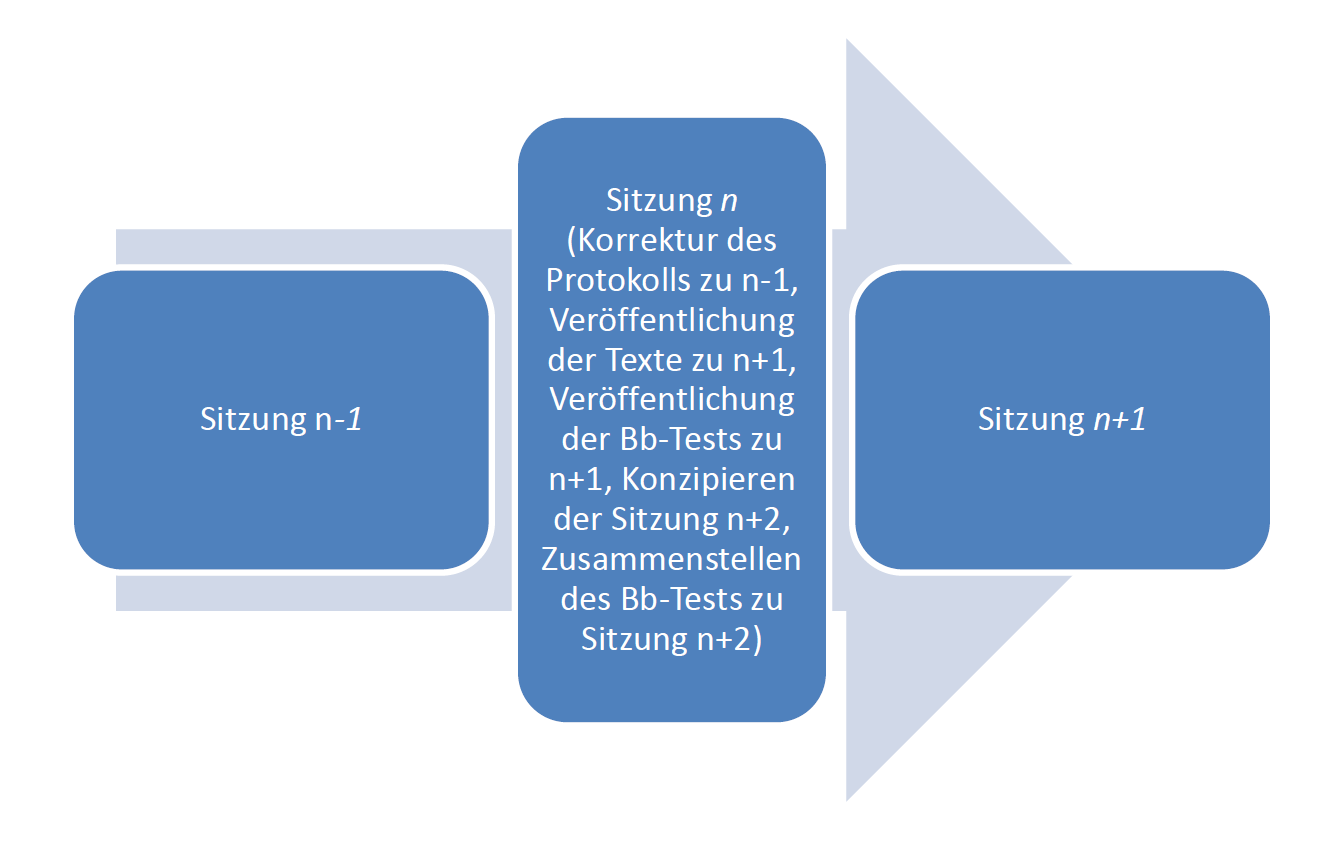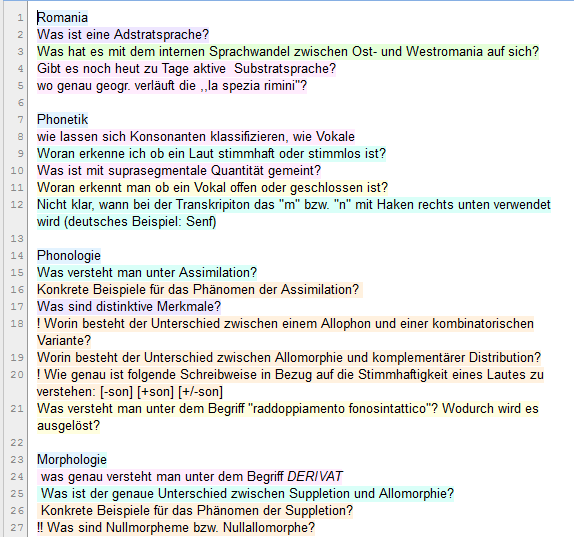Course
| Course title | "Introduction to Linguistics" (GK B) |
| Coure type | Basic course |
Lecturer | Valerie Hekkel |
No. of participants | approx. 15 |
Phase | Parallel to the face-to-face sessions, preparation and follow-up of the sessions, intensified usage for exam preparation |
Duration | Course-accompanying, 1 semester |
Tools
- Blackboard
- Blackboard tests
- Backboard wiki
- Further web 2.0 tools, e.g.:
- Prezi
- Titanpad
- Pingo
External tools can be implemented as a supplement to the central systems of the Freie Universität (wiki, blog, LMS etc.). The description of the external applications (information on tools, implementation scenarios, practical examples) can be found in the IdeasBar for teaching and science 2.0.
Realization
The blended learning course consists of the following three phases on a weekly basis: the preparation, the face-to-face session and the follow-up. Both the phase of preparation as well as follow-up are transferred to Blackboard-supported home study sessions. The preparatory work for the students consists of working through the session-relevant and topic-related literature as well as the subsequent working on corresponding tests in Blackboard. These tests are voluntary; however, half of the final exam is made up of these Blackboard test questions. The follow-up of each session consists of writing up the meeting minutes which is undertaken by a small group and recorded in the Blackboard wiki system.
For a successful implementation of the blended learning concept it is on the one hand necessary that the provision of content is consequently planned and provided in a timely manner, and on the other hand it has to be ensured that the Blackboard course structure is clear with a good overview so that the students can clearly see this and can find what they need when they need it. For this purpose the navigation buttons were reduced to News, Lecturer (a block that led to course information that was independent of the course contents), Course materials, Notes wiki, Tests (a block on the components of the blended learning design), Discussion forum and Mailing list (a block for communication).
The concept requires the following timing:
What? | By whom? | When? |
PREPARATION | ||
Posting the literature needed to prepare for the next session | Lecturer | One week before the session |
Creating and activating the corresponding Blackboard tests | Lecturer | Activation one week before the session, setting it up beforehand with the time needed for this |
Detailed planning of the face-to-face session | Lecturer | Ideally 2 weeks before the session, so that the Blackboard test and the literature required can be selected and if needs be adjusted. The design of the slides can also take place in the week before the session. |
Working on the tests and reading the literature | Students | As of one week before the session |
FOLLOW-UP | ||
Writing up the session's minutes | Weekly changing small groups (students) | Up to 1 week after the session |
Correcting the minutes | Lecturer | On the day of the subsequent session |
Presented differently, this means the following for the lecturer when it comes to the timing:
Illustration 1: Time planning
Apart from the weekly recurring work phases, digital media was also used intermittently. For example, for the preparation of the last session the students used a Titanpad to create a catalog of questions still open and unanswered (Illustration 2) which were answered and discussed with the help of the online tool Pingo (Illustration 3).
Illustration 2: Question catalog in the Titanpad
Illustration 3: Questions per clicker (Pingo)
Experiences made by the lecturer
All in all, the blended learning concept can be rated as a success. The literature was indeed read beforehand, the Blackboard tests were worked on by about 50% of the students on a weekly basis. Therefore the final exam grade was quite positive - as well as the feedback from the students. Especially the Blackboard tests were seen as being a sensible preparation for the final exam. However, designing a blended learning course is a lot more work (not least due to the strict time plan) which turned into a manageable and quite doable routine after a while.
Further information
Support offered by CeDiS
- Consulting services for the implementation of digital solutions in teaching: The Center for Digital Systems (CeDiS) has extensive experience of many years when it comes to the implementation of digital media and systems within the fields of teaching, learning and research. We offer a wide variety of consulting services on the implementation of these tools and systems within the entire academic scope and especially at Freie Universität Berlin.
- Training courses and workshops: For lecturers at Freie Universität Berlin (professors, employees, tutors) as well as lecturers of other universities CeDiS offers training courses and workshops on the topic of teaching and learning with digital media. These course enable participants to implement online elements within their own sphere of teaching.
- Lehrgänge zu Web 2.0 und Social Media an der Freien UniversitätDas Präsidium der Freien Universität unterstützt E-Learning-Initiativen: Mit dem E-Learning-Förderprogramm werden finanzielle Mittel für Lehrende zur Verfügung gestellt, die ihre Lehrveranstaltungen nachhaltig durch Technologie- und Medienunterstützung bereichern und qualitativ verbessern. Es können alle in der Lehre tätigen Wissenschaftler/innen bzw. Institutionen der Freien Universität ohne die Charité-Universitätsmedizin gefördert werden.





